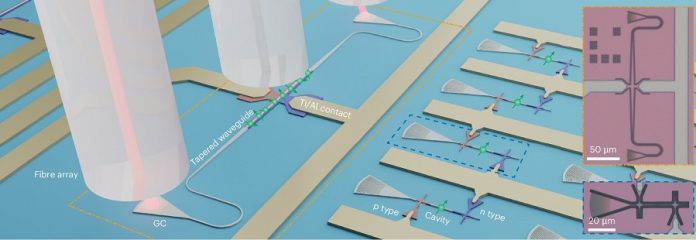
Physicists in Canada have achieved a major step forward in the race to build practical quantum computers.
A team from Simon Fraser University’s Quantum Technology Lab, working with the Canadian quantum company Photonic Inc., has created a new type of silicon-based quantum device that can be controlled by both light and electricity.
The breakthrough, reported in Nature Photonics, could accelerate the development of powerful quantum machines with the potential to transform computing, medicine, and cybersecurity.
The devices are based on special flaws in silicon crystals called color centers, which can act as quantum bits, or qubits.
Specifically, the researchers worked with “T centers,” a kind of silicon color center that can emit single particles of light, or photons. Until now, scientists could only control these T centers using lasers.
The new work shows, for the first time, that they can also be controlled electrically, offering more flexibility and opening the door to scalable quantum technologies.
“This is the first-ever demonstration of an electrically injected single-photon source in silicon,” explained Daniel Higginbottom, an assistant professor of physics at SFU. “Before, we only had optical control.
Now we have both, which is a critical step toward building scalable quantum computers.”
The team’s new diode nanocavity devices are designed to generate and control single photons with extreme precision.
Lead author and Ph.D. candidate Michael Dobinson said the advance is especially exciting because it makes the technology more practical for real-world use. “This first demonstration shows that we can fabricate devices which allow for simultaneous optical and electrical control of T centers,” he said.
“Overall, the optical and electrical operation combined with the silicon platform makes this a very scalable and broadly applicable device.”
Photonic Inc., co-founded by SFU researchers Stephanie Simmons and Mike Thewalt, played a key role in the project by providing advanced fabrication expertise.
“This project was a great opportunity to leverage Photonic’s fabrication capabilities and test performance in next-generation devices,” said co-author Christian Dangel.
The company is pushing forward with plans to commercialize silicon-based quantum technologies, including the establishment of a new research facility in the U.K.
The advantage of building quantum devices on silicon is clear: the global semiconductor industry already manufactures silicon chips with extraordinary precision at massive scale. By harnessing that same infrastructure for quantum technology, researchers hope to speed up development and lower costs.
The SFU lab has been at the forefront of this field for years. In 2020, it introduced silicon T centers for quantum applications.
By 2022, researchers had integrated them with nanophotonic devices, though without practical controls. Now, with the addition of electrical and optical interfaces, the building blocks of a useful quantum computer are taking shape.
“It’s thrilling to be on this trajectory,” Higginbottom said. “We’re finally unlocking some of the capabilities needed to build a real quantum computer out of silicon.”
Source: Simon Fraser University.



